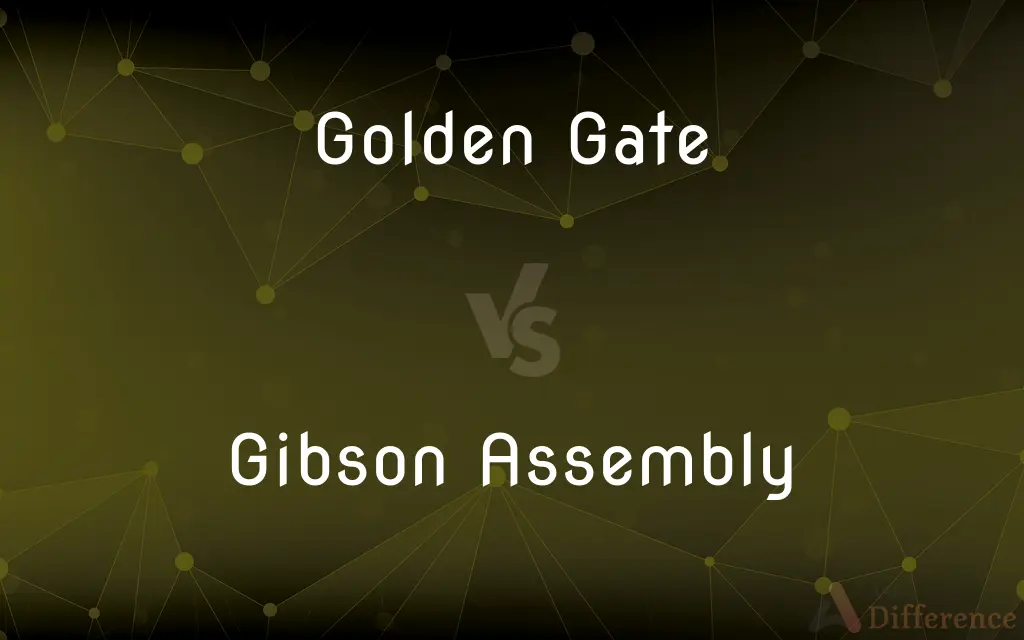Golden Gate vs. Gibson Assembly — What's the Difference?
By Tayyaba Rehman — Published on November 15, 2023
Golden Gate is a cloning method using Type IIS restriction enzymes and T4 ligase, while Gibson Assembly joins DNA fragments by overlapping sequences without restriction enzymes. Both are techniques for DNA assembly.

Difference Between Golden Gate and Gibson Assembly
Table of Contents
ADVERTISEMENT
Key Differences
In the world of molecular biology, both Golden Gate and Gibson Assembly are recognized as advanced techniques for DNA assembly. These methods, however, have distinct mechanisms and applications.
The Golden Gate assembly utilizes Type IIS restriction enzymes, which cleave DNA outside their recognition sites, leaving overhangs. Coupled with T4 DNA ligase, this allows for the seamless joining of multiple DNA fragments in a specific order.
On the other hand, Gibson Assembly does not rely on restriction enzymes. Instead, it makes use of the natural overlaps between DNA fragments. These overlaps guide a mix of enzymes to simultaneously cleave and join the fragments, ensuring a precise assembly.
While both Golden Gate and Gibson Assembly are versatile and enable the creation of complex DNA constructs, the choice between them often depends on the specifics of a project. The Golden Gate is known for its efficiency in building repetitive sequences, whereas Gibson Assembly is prized for its flexibility in joining various DNA fragments.
Comparison Chart
Enzyme Usage
Uses Type IIS restriction enzymes and T4 DNA ligase.
Does not use restriction enzymes.
ADVERTISEMENT
Overlaps
Overhangs generated by restriction enzymes.
Uses natural overlaps between DNA fragments.
Flexibility
High specificity due to enzyme choice.
Greater flexibility with fragment choice.
Efficiency with Repeats
Highly efficient for assembling repetitive sequences.
Less efficient for repetitive sequences.
Complexity
Best for assembling multiple fragments in specific order.
Best for joining various fragments without a set order.
Compare with Definitions
Golden Gate
A technique enabling seamless joining of multiple DNA fragments.
Using Golden Gate, researchers can avoid unwanted scar sequences between fragments.
Gibson Assembly
A method prized for flexibility in fragment choice.
With Gibson Assembly, researchers can join various fragments without considering restriction sites.
Golden Gate
A DNA assembly method known for high efficiency with repetitive sequences.
For tandem repeat constructs, Golden Gate is the preferred assembly method.
Gibson Assembly
A technique that doesn't leave scars between joined fragments.
Gibson Assembly ensures that the final product is free from unwanted sequences.
Golden Gate
A method that requires a specific enzyme choice for specificity.
The success of a Golden Gate assembly often depends on the correct choice of restriction enzymes.
Gibson Assembly
A solution for assembling large and complex DNA constructs.
For assembling whole synthetic genomes, Gibson Assembly is often a method of choice.
Golden Gate
A cloning strategy that can introduce multiple fragments in a desired order.
With Golden Gate, it's possible to assemble a multi-gene pathway in a single step.
Gibson Assembly
A cloning method that uses overlapping sequences to join DNA fragments.
Gibson Assembly allows for the creation of large DNA constructs without restriction enzymes.
Golden Gate
A molecular cloning method using Type IIS restriction enzymes.
The Golden Gate assembly is ideal for building synthetic biology constructs.
Gibson Assembly
An enzyme mix-driven technique for DNA assembly.
The Gibson Assembly mix contains enzymes that cleave and ligate DNA simultaneously.
Common Curiosities
Can Golden Gate assembly handle repetitive sequences efficiently?
Yes, Golden Gate is highly efficient for assembling repetitive sequences.
What is the primary enzyme used in Golden Gate assembly?
The Golden Gate primarily uses Type IIS restriction enzymes.
Does Gibson Assembly require restriction enzymes?
No, Gibson Assembly does not rely on restriction enzymes.
Does the Golden Gate method leave scars between fragments?
No, Golden Gate assembly results in scarless joins.
How are overlaps created in Gibson Assembly?
In Gibson Assembly, overlaps are typically created during PCR amplification of DNA fragments.
What makes Gibson Assembly flexible?
Gibson Assembly allows joining of fragments without considering restriction sites, adding to its flexibility.
How does Golden Gate ensure correct fragment order?
Golden Gate uses enzyme specificity to ensure fragments join in a desired order.
Is Gibson Assembly suitable for complex constructs?
Yes, Gibson Assembly is ideal for assembling large and complex DNA constructs.
Is it easy to multiplex with Golden Gate assembly?
Yes, Golden Gate is suitable for multiplexing and assembling multiple fragments in one reaction.
Are there kits available for Gibson Assembly?
Yes, there are commercial kits available that simplify the Gibson Assembly process.
Can you clone large fragments using Gibson Assembly?
Yes, Gibson Assembly is capable of assembling large DNA fragments effectively.
Is Golden Gate assembly a high-throughput method?
Golden Gate can be adapted for high-throughput applications, especially when building synthetic biology constructs.
What is the main advantage of Gibson Assembly over traditional cloning?
Gibson Assembly allows seamless joining of fragments without the need for restriction enzymes.
Are there any sequence restrictions in Golden Gate?
Yes, Golden Gate requires specific recognition sites for the chosen restriction enzymes.
How do you choose between Golden Gate and Gibson Assembly for a project?
The choice between Golden Gate and Gibson Assembly often depends on project specifics like desired fragment order, presence of repetitive sequences, and available DNA materials.
Share Your Discovery

Previous Comparison
Self-esteem vs. Self-efficacy
Next Comparison
Subject Complement vs. Direct ObjectAuthor Spotlight
Written by
Tayyaba RehmanTayyaba Rehman is a distinguished writer, currently serving as a primary contributor to askdifference.com. As a researcher in semantics and etymology, Tayyaba's passion for the complexity of languages and their distinctions has found a perfect home on the platform. Tayyaba delves into the intricacies of language, distinguishing between commonly confused words and phrases, thereby providing clarity for readers worldwide.











































